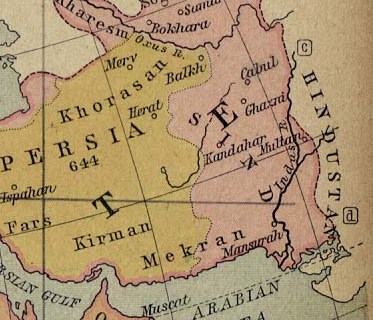File:Ancient Khorasan highlighted.jpg
Appearance
Ancient_Khorasan_highlighted.jpg (373 × 320 pixels, file size: 58 KB, MIME type: image/jpeg)
File history
Click on a date/time to view the file as it appeared at that time.
| Date/Time | Thumbnail | Dimensions | User | Comment | |
|---|---|---|---|---|---|
| current | 19:07, 22 October 2010 |  | 373 × 320 (58 KB) | Officer | {{Information |Description= |Source= |Date= |Author= |Permission= |other_versions= }} |
File usage
The following 18 pages use this file:
- Al-Mansur
- Delhi–Multan road
- Greater Khorasan
- History of Afghanistan
- History of Arabs in Afghanistan
- Jewish mythology
- Kabul
- List of sieges of Kabul
- Muslim conquest of Persia
- Muslim conquests of Afghanistan
- Siege of Kabul (1504)
- Talk:Afghanistan/Archive 8
- User:Falcaorib/Afghanistan
- User:Falcaorib/Iran
- User:Falcaorib/Medieval Empires (500-650 AD)
- User:HistoryofIran/Greater Khorasan
- User:Northamerica1000/Portals of the world
- Portal:Afghanistan
Global file usage
The following other wikis use this file:
- Usage on an.wikipedia.org
- Usage on ar.wikipedia.org
- Usage on arz.wikipedia.org
- Usage on azb.wikipedia.org
- Usage on ba.wikipedia.org
- Usage on bn.wikipedia.org
- Usage on ca.wikipedia.org
- Usage on ckb.wikipedia.org
- Usage on de.wikipedia.org
- Usage on el.wikipedia.org
- Usage on en.wiktionary.org
- Usage on eo.wikipedia.org
- Usage on es.wikipedia.org
- Usage on fa.wikipedia.org
- Usage on fi.wikipedia.org
- Usage on fr.wikipedia.org
- Usage on gl.wikipedia.org
- Usage on he.wikipedia.org
- Usage on hi.wikipedia.org
- Usage on hr.wikipedia.org
- Usage on hy.wikipedia.org
- Usage on id.wikipedia.org
- Usage on it.wikipedia.org
View more global usage of this file.

